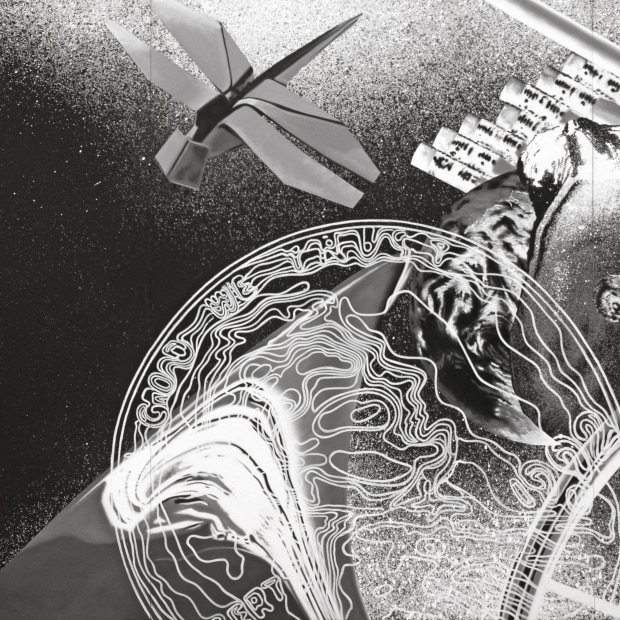James Rosenquist
-
-
Kasmin is thrilled to present an exhibition of paintings by James Rosenquist, staged in collaboration with the Estate of James Rosenquist, on view at 509 West 27th Street from April 28–June 4, 2022. Realized between 1989 and 1992, the works share several unique formal elements that combine in a compelling exploration of the rapidly changing world of the late 20th century. Blending abstract forms and figuration in a dynamic cacophony of imagery, the works probe both ecological and political themes and can be read as both celebrations of natural habitats as well as elegies to their desecration on a global and cosmic scale. Searingly relevant today, Rosenquist’s approach to image-making tests the possibilities of perception and asks us to consider forms of consumerism and consumption that affect our climate, our natural world, and the space our planet inhabits.
-
Spanning 35 feet, Time Dust-Black Hole (1992) embodies both the ambition of Rosenquist's artistic vision and the enormity of his themes. The monumental composition depicts an unexpected collection of detritus from human travels and exploration-including a sailboat, an aluminum pop-top can, a French horn, and the outline of a US penny-frozen as if subjects in an imagined museum of 20th century material culture. References to the military industrial complex abound, complicated by the melding of images and deliberate formal inconsistencies. The work is painted in grayscale, imbuing its composition and themes with an ever-greater potency and graphic immediacy. Rosenquist once said, "I want people who look at my paintings to be able to pass through the illusory surface of the canvas and enter a space where the ideas in my head collide with theirs." Read metaphorically, the environment of the work becomes a stand-in for that peculiar locus of creativity, the imagination, where unrelated imagery comes together unexpectedly to form new sites of meaning. Rosenquist's working process saw the artist build a personal collection of reproduced images from wide-ranging sources including glossy magazine advertisements, engineering manuals, mechanical magazines, and scientific documents on plant life. Fragmenting and cropping these images, and adding the skillful gestures he learned during his time as a sign painter, Rosenquist extrapolates from this source imagery to create a visual language distinct from his contemporaries in Pop art, as well as related precedents in Surrealism and Abstract Expressionism.
-
-
The earliest of the works on view is Sky Hole (1989), which forms a bridge between the formal concerns of the artist’s Welcome to the Water Planet series of the 1980s and the artist's increasing interest in cosmic environments. With a title that conjures images of this earthly planet and the cosmos beyond, the work is partitioned, rendered across two canvases where the divide acts as both a horizon line and a portal from one world to the other. While the upper canvas ripples with Floridian turquoise waters framed by blooming pink flowers, the lower segment renders a dark, swirling galaxy partially obscured by a human face.
-
-
By 1990, Rosenquist returns to abstract forms as a mode to explore and represent certain existential realities. (The artist had abandoned nonobjective forms in his early work almost six decades prior, turning to the realistic compositions of fragmented imagery that defined his Pop art sensibility in the early 1960s.) In this late style, however, exemplified by Red and Green Vascular Bundles (1992) he dives into a dazzling kaleidoscopic world that appears constantly in motion.
-
-
Recurring throughout many works in this presentation is a circular constellation of dots inspired by the Ishihara Color Blind Test. Traditionally organized with numbers rendered among dots seemingly randomized in color and size to test red-green color blindness, Rosenquist reimagines these in an exploration of vision, sight, and perception. The artist said of the work, “These are, in a sense, technical colors, not emotional colors. I was trying to stay away from the emotional impact of color because I wanted to tone down the expressive content of the image. There must be meaning underlying the image—even if the viewer doesn’t know what it is. It’s the psychic goo that binds the whole picture together.” Exploding Pollen (1992) replaces the requisite central number with the semi-abstracted shape of a honeybee, an insect critical in, and symbolic of, the interdependence of our food systems. In Imagine an Apple Eaten (1990) Rosenquist pairs this motif with images of military aircraft against the backdrop of an exploding star and the outline of a halved apple. The work is steeped in Rosenquist’s social consciousness as he reflects on the ongoing famine in the Sudan during this time.
-

-
Works
-
The Kasmin Review

-
About the Artist
 James Rosenquist installing Horse Blinders (1968–69), Wallraf-Richartz-Museum, Cologne, 1972. Photo by Wolf P. Prange. Artwork
James Rosenquist installing Horse Blinders (1968–69), Wallraf-Richartz-Museum, Cologne, 1972. Photo by Wolf P. Prange. Artwork -
Explore
-

Alexis Ralaivao: Éloge de l’ombre (In Praise of Shadows)
May 15 – July 25, 2025 509 West 27th Street, New YorkFor Éloge de l’ombre (In Praise of Shadows), Ralaivao unveils a suite of new paintings rendered entirely in black and white. Working within the self-imposed parameters of a reduced palette,... -

Theodora Allen: Oak
May 7 – July 25, 2025 297 Tenth Avenue, New YorkAllen’s atmospheric oil paintings on linen depict natural phenomena and symbols chosen for their enduring presence in human history and culture, often drawing from mythology and medieval imagery. From hearts... -

Alma Allen on Park Avenue
May 2 – September 30, 2025In Alma Allen's largest outdoor installation to date, ten unique bronze and onyx sculptures including examples reaching over 10 feet tall and realized especially for the exhibition, are on view...
-

























